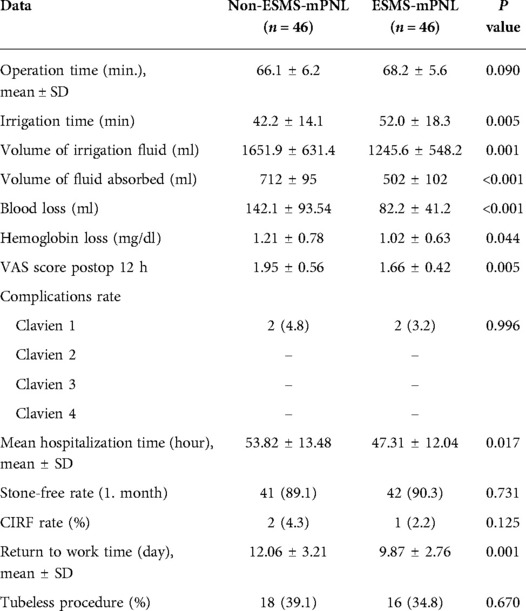- 1Department of Urology, Lanzhou University Second Hospital, Lanzhou. China
- 2Lanzhou University Second Hospital, Lanzhou, China
- 3The University of Texas Health Science Center at San Antonio, San Antonio, TX, United States
A corrigendum on
by Gui H, Wang H, Kaushik D, Rodriguez R and Wang Z (2022). Front. Surg. 9:773270. doi: 10.3389/fsurg.2022.773270
In the published article, there was an error caused by incorrect writing. A correction has been made to the Abstract of Section. This sentence previously stated:
“… however, the patients in the ESMS-mPNL group had significantly longer operation times than those in the non-ESMS-mPNL subgroup, along with marked reductions in irrigation fluid absorption, blood loss, haemoglobin loss, 12 h postoperative VAS score, mean hospitalization time, and return to work time.”
The corrected sentence appears below:
“… however, the patients in the ESMS-mPNL group had significantly longer irrigation times than those in the non-ESMS-mPNL subgroup, along with marked reductions in irrigation fluid, blood loss, haemoglobin loss, 12 h postoperative VAS score, mean hospitalization time, and return to work time.”
In the published article, there was an error in the legend for [Table 4] as published. [Caused by incorrect writing].
The corrected [Table 4] and its caption **[Comparison of operative data and complications for Non-ESMS-mPNL vs ESMS-mPNL groups.] appear below.
In the published article, there were some errors caused by incorrect writing.
A correction has been made to the Results of Section. This sentence previously stated:
“[A longer irrigation time (52.0 ± 18.3 vs. 42.2 ± 14.1 min) and a larger volume of absorbed fluid (712 ± 95 vs. 502 ± 102 ml) were observed in the patients in the ESMS-mPNL group compared with those in the non-ESMS-mPNL group (P = 0.005 and P < 0.001, respectively).]”
The corrected sentence appears below:
“[A longer irrigation time (52.0 ± 18.3 vs. 42.2 ± 14.1 min) and a smaller volume of absorbed fluid (502 ± 102 vs. 712 ± 95 ml) were observed in the patients in the ESMS-mPNL group compared with those in the non-ESMS-mPNL group (P = 0.005 and P < 0.001, respectively).]”
Two corrections have been made to the Discussion of Section. This sentence previously stated:
“[The ESMS-mPNL group had a significantly longer irrigation time and a larger volume of fluid absorbed than the non-ESMS-mPNL group (but these values were clinically comparable),]”
The corrected sentence appears below:
“[The ESMS-mPNL group had a significantly longer irrigation time and a smaller volume of fluid absorbed than the non-ESMS-mPNL group (but these values were clinically comparable),]”
This sentence previously stated:
“[The volume of fluid absorbed during ESMS-mPNL increased significantly compared to the non-ESMS-mPNL group, and the endoscopic surgical monitoring system might promote better fluid absorption during ESMS-mPNL than during non-ESMS-mPNL.]”
The corrected sentence appears below:
“[The volume of fluid absorbed during ESMS-mPNL decreased significantly compared to the non-ESMS-mPNL group, and the endoscopic surgical monitoring system might promote better fluid absorption during ESMS-mPNL than during non-ESMS-mPNL.]”
We apologize for this mistake and declare that this correction will not change the scientific conclusion of this article. The original article has been updated.
Keywords: standard percutaneous nephrolithotomy, mini-percutaneous nephrolithotomy, endoscopic surgical monitoring system, renal calculus, retrospective study
Citation: Gui H, Wang H, Kaushik D, Rodriguez R and Wang Z (2022) Corrigendum: Mini-percutaneous nephrolithotomy with an endoscopic surgical monitoring system for the management of renal stones: A retrospective evaluation. Front. Surg. 9:999166. doi: 10.3389/fsurg.2022.999166
Received: 20 July 2022; Accepted: 21 July 2022;
Published: 10 August 2022.
Edited by:
Frontiers in Surgery Editorial Office, Frontiers Media SA, Switzerland© 2022 Gui, Wang, Kaushik, Rodriguez and Wang. This is an open-access article distributed under the terms of the Creative Commons Attribution License (CC BY). The use, distribution or reproduction in other forums is permitted, provided the original author(s) and the copyright owner(s) are credited and that the original publication in this journal is cited, in accordance with accepted academic practice. No use, distribution or reproduction is permitted which does not comply with these terms.
*Correspondence: Zhiping Wang ZXJ5d3pwQGx6dS5lZHUuY24=
Specialty Section: This article was submitted to Genitourinary Surgery, a section of the journal Frontiers in Surgery
 Huiming Gui
Huiming Gui Hanzhang Wang2
Hanzhang Wang2 Zhiping Wang
Zhiping Wang